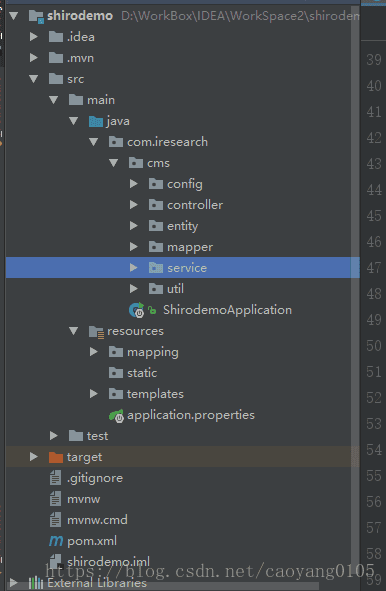一 、介绍shiro框架
Apache Shiro是一个强大且易用的Java安全框架,执行身份验证、授权、密码学和会话管理。Shiro 主要分为来个部分就是认证和授权两部分
Subject
Subject即主体,外部应用与subject进行交互,subject记录了当前操作用户,将用户的概念理解为当前操作的主体,可能是一个通过浏览器请求的用户,也可能是一个运行的程序。 Subject在shiro中是一个接口,接口中定义了很多认证授相关的方法,外部程序通过subject进行认证授,而subject是通过SecurityManager安全管理器进行认证授权
SecurityManager
SecurityManager即安全管理器,对全部的subject进行安全管理,它是shiro的核心,负责对所有的subject进行安全管理。通过SecurityManager可以完成subject的认证、授权等,实质上SecurityManager是通过Authenticator进行认证,通过Authorizer进行授权,通过SessionManager进行会话管理等。
SecurityManager是一个接口,继承了Authenticator, Authorizer, SessionManager这三个接口。
Authenticator
Authenticator即认证器,对用户身份进行认证,Authenticator是一个接口,shiro提供ModularRealmAuthenticator实现类,通过ModularRealmAuthenticator基本上可以满足大多数需求,也可以自定义认证器。
Authorizer
Authorizer即授权器,用户通过认证器认证通过,在访问功能时需要通过授权器判断用户是否有此功能的操作权限。
realm
Realm即领域,相当于datasource数据源,securityManager进行安全认证需要通过Realm获取用户权限数据,比如:如果用户身份数据在数据库那么realm就需要从数据库获取用户身份信息。
注意:不要把realm理解成只是从数据源取数据,在realm中还有认证授权校验的相关的代码。
sessionManager
sessionManager即会话管理,shiro框架定义了一套会话管理,它不依赖web容器的session,所以shiro可以使用在非web应用上,也可以将分布式应用的会话集中在一点管理,此特性可使它实现单点登录。X
二、shiro的实现
整体的项目目录

1.添加jar包
<dependency> <groupId>org.apache.shiro</groupId> <artifactId>shiro-spring</artifactId> <version>1.4.0</version> </dependency>
2.配置配置文件
spring.datasource.url= jdbc:mysql://localhost:3306/test?useUnicode=true&characterEncoding=utf8 spring.datasource.username=root spring.datasource.password=root spring.datasource.driver-class-name=com.mysql.jdbc.Driver spring.datasource.type=com.alibaba.druid.pool.DruidDataSource #spring.datasource.schema=database/import.sql spring.thymeleaf.cache=false spring.thymeleaf.mode=LEGACYHTML5 spring.jpa.database=mysql #spring.jpa.show-sql=true spring.jpa.hibernate.ddl-auto=update spring.jpa.hibernate.naming.strategy=org.hibernate.cfg.DefaultComponentSafeNamingStrategy spring.jpa.properties.hibernate.dialect: org.hibernate.dialect.MySQL5Dialect mybatis.mapper-locations=classpath:mapping/*.xml
3.自定义Realm 继承AuthorizingRealm 重写 AuthorizationInfo(授权) 和 AuthenticationInfo(认证)这两个
public class MyShiroRealm extends AuthorizingRealm {
@Resource
private UserInfoService userInfoService;
@Override
protected AuthorizationInfo doGetAuthorizationInfo(PrincipalCollection principals) {
System.out.println("权限配置-->MyShiroRealm.doGetAuthorizationInfo()");
SimpleAuthorizationInfo authorizationInfo = new SimpleAuthorizationInfo();
SysUser userInfo = (SysUser)principals.getPrimaryPrincipal();
Integer uid = userInfo.getUid();
List<SysRole> r = userInfoService.getAllRole(uid);
userInfo.setRoleList(r);
for(SysRole role:userInfo.getRoleList()){
authorizationInfo.addRole(role.getRole());
List<SysPermission> per = userInfoService.getAllPermission(role.getId());
role.setPermissions(per);
for(SysPermission p:role.getPermissions()){
authorizationInfo.addStringPermission(p.getPermission());
}
}
return authorizationInfo;
}
/*主要是用来进行身份认证的,也就是说验证用户输入的账号和密码是否正确。*/
@Override
protected AuthenticationInfo doGetAuthenticationInfo(AuthenticationToken token)
throws AuthenticationException {
System.out.println("MyShiroRealm.doGetAuthenticationInfo()");
//获取用户的输入的账号.
String username = (String)token.getPrincipal();
System.out.println(token.getCredentials());
//通过username从数据库中查找 User对象,如果找到,没找到.
//实际项目中,这里可以根据实际情况做缓存,如果不做,Shiro自己也是有时间间隔机制,2分钟内不会重复执行该方法
SysUser userInfo = userInfoService.findByUsername(username);
System.out.println("----->>userInfo="+userInfo.getPassword());
if(userInfo == null){
return null;
}
SimpleAuthenticationInfo authenticationInfo = new SimpleAuthenticationInfo(
userInfo, //用户名
userInfo.getPassword(), //密码
ByteSource.Util.bytes(userInfo.getCredentialsSalt()),//salt=username+salt
getName() //realm name
);
return authenticationInfo;
}
}4.配置过滤配置
@Configuration
public class ShiroConfig {
@Bean
public ShiroFilterFactoryBean shirFilter(SecurityManager securityManager) {
System.out.println("ShiroConfiguration.shirFilter()");
ShiroFilterFactoryBean shiroFilterFactoryBean = new ShiroFilterFactoryBean();
shiroFilterFactoryBean.setSecurityManager(securityManager);
//拦截器.
//必须是LinkedHashMap,因为要保证有序
Map<String,String> filterChainDefinitionMap = new LinkedHashMap<String,String>();
// 配置不会被拦截的链接 顺序判断
filterChainDefinitionMap.put("/static/**", "anon");
filterChainDefinitionMap.put("/submitLogin","anon");
//配置退出 过滤器,其中的具体的退出代码Shiro已经替我们实现了
filterChainDefinitionMap.put("/logout", "logout");
//<!-- 过滤链定义,从上向下顺序执行,一般将/**放在最为下边 -->:这是一个坑呢,一不小心代码就不好使了;
//<!-- authc:所有url都必须认证通过才可以访问; anon:所有url都都可以匿名访问-->
filterChainDefinitionMap.put("/**", "authc");
// 如果不设置默认会自动寻找Web工程根目录下的"/login.jsp"页面
shiroFilterFactoryBean.setLoginUrl("/login");
// 登录成功后要跳转的链接
shiroFilterFactoryBean.setSuccessUrl("/index");
//未授权界面;
shiroFilterFactoryBean.setUnauthorizedUrl("/403");
shiroFilterFactoryBean.setFilterChainDefinitionMap(filterChainDefinitionMap);
return shiroFilterFactoryBean;
}
/**
* 凭证匹配器
* (由于我们的密码校验交给Shiro的SimpleAuthenticationInfo进行处理了
* )
* @return
*/
@Bean
public HashedCredentialsMatcher hashedCredentialsMatcher(){
HashedCredentialsMatcher hashedCredentialsMatcher = new HashedCredentialsMatcher();
hashedCredentialsMatcher.setHashAlgorithmName("md5");//散列算法:这里使用MD5算法;
hashedCredentialsMatcher.setHashIterations(2);//散列的次数,比如散列两次,相当于 md5(md5(""));
return hashedCredentialsMatcher;
}
@Bean
public MyShiroRealm myShiroRealm(){
MyShiroRealm myShiroRealm = new MyShiroRealm();
myShiroRealm.setCredentialsMatcher(hashedCredentialsMatcher());
return myShiroRealm;
}
@Bean
public SecurityManager securityManager(){
DefaultWebSecurityManager securityManager = new DefaultWebSecurityManager();
securityManager.setRealm(myShiroRealm());
return securityManager;
}
/**
* 开启shiro aop注解支持.
* 使用代理方式;所以需要开启代码支持;
* @param securityManager
* @return
*/
@Bean
public AuthorizationAttributeSourceAdvisor authorizationAttributeSourceAdvisor(SecurityManager securityManager){
AuthorizationAttributeSourceAdvisor authorizationAttributeSourceAdvisor = new AuthorizationAttributeSourceAdvisor();
authorizationAttributeSourceAdvisor.setSecurityManager(securityManager);
return authorizationAttributeSourceAdvisor;
}
@Bean(name="simpleMappingExceptionResolver")
public SimpleMappingExceptionResolver
createSimpleMappingExceptionResolver() {
SimpleMappingExceptionResolver r = new SimpleMappingExceptionResolver();
Properties mappings = new Properties();
mappings.setProperty("DatabaseException", "databaseError");//数据库异常处理
mappings.setProperty("UnauthorizedException","403");
r.setExceptionMappings(mappings); // None by default
r.setDefaultErrorView("error"); // No default
r.setExceptionAttribute("ex"); // Default is "exception"
//r.setWarnLogCategory("example.MvcLogger"); // No default
return r;
}
}5.实体类
user 用户类
@Entity
public class SysUser implements Serializable {
@Id
@GeneratedValue
private Integer uid;
@Column(unique =true)
private String username;//帐号
private String name;//名称(昵称或者真实姓名,不同系统不同定义)
private String password; //密码;
private String salt;//加密密码的盐
private byte state;//用户状态,0:创建未认证(比如没有激活,没有输入验证码等等)--等待验证的用户 , 1:正常状态,2:用户被锁定.
@ManyToMany(fetch= FetchType.EAGER)//立即从数据库中进行加载数据;
@JoinTable(name = "SysUserRole", joinColumns = { @JoinColumn(name = "uid") }, inverseJoinColumns ={@JoinColumn(name = "roleId") })
private List<SysRole> roleList;// 一个用户具有多个角色role 角色类
@Entity
public class SysRole {
@Id@GeneratedValue
private Integer id; // 编号
private String role; // 角色标识程序中判断使用,如"admin",这个是唯一的:
private String description; // 角色描述,UI界面显示使用
private Boolean available = Boolean.FALSE; // 是否可用,如果不可用将不会添加给用户
//角色 -- 权限关系:多对多关系;
@ManyToMany(fetch= FetchType.EAGER)
@JoinTable(name="SysRolePermission",joinColumns={@JoinColumn(name="roleId")},inverseJoinColumns={@JoinColumn(name="permissionId")})
private List<SysPermission> permissions;
// 用户 - 角色关系定义;
@ManyToMany
@JoinTable(name="SysUserRole",joinColumns={@JoinColumn(name="roleId")},inverseJoinColumns={@JoinColumn(name="uid")})
private List<SysUser> userInfos;// 一个角色对应多个用户permission 权限类
@Entity
public class SysPermission implements Serializable {
@Id@GeneratedValue
private Integer id;//主键.
private String name;//名称.
@Column(columnDefinition="enum('menu','button')")
private String resourceType;//资源类型,[menu|button]
private String url;//资源路径.
private String permission; //权限字符串,menu例子:role:*,button例子:role:create,role:update,role:delete,role:view
private Long parentId; //父编号
private String parentIds; //父编号列表
private Boolean available = Boolean.FALSE;
@ManyToMany
@JoinTable(name="SysRolePermission",joinColumns={@JoinColumn(name="permissionId")},inverseJoinColumns={@JoinColumn(name="roleId")})
private List<SysRole> roles;6.接下来编写controller
@RequestMapping(value="/submitLogin",method = RequestMethod.POST)
@ResponseBody
public Map<String, Object> submitLogin(String username,String password){
System.out.println(username+"-----"+password);
String msg = "";
Map<String, Object> map = new HashMap<>();
try {
UsernamePasswordToken token = token = new UsernamePasswordToken(username, password);
char[] password1 = token.getPassword();
String s = password1.toString();
System.out.println("*******"+s);
SecurityUtils.getSubject().login(token);
token.setRememberMe(true);
map.put("status",200);
} catch (UnknownAccountException e) {
msg = "UnknownAccountException -- > 账号不存在:";
map.put("status",400);
} catch (IncorrectCredentialsException e){
msg = "IncorrectCredentialsException -- > 密码不正确:";
map.put("status",500);
}catch (Exception exception){
msg = "else >> "+exception;
System.out.println("else -- >" + exception);
}
return map;
}